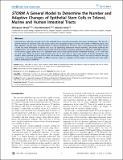STORM: A General Model to Determine the Number and Adaptive Changes of Epithelial Stem Cells in Teleost, Murine and Human Intestinal Tracts
Author(s)
Wang, Zhengyuan; Gong, Zhiyuan; Matsudaira, Paul T.
DownloadWang-2010-STORM A General Model to Determine the Number and Adaptive Changes of Epithelial Stem Cells in Teleost, Murine and Human Intestinal Tracts.pdf (423.9Kb)
PUBLISHER_CC
Publisher with Creative Commons License
Creative Commons Attribution
Terms of use
Metadata
Show full item recordAbstract
Intestinal stem cells play a pivotal role in the epithelial tissue renewal, homeostasis and cancer development. The lack of a general marker for intestinal stem cells across species has hampered analysis of stem cell number in different species and their adaptive changes upon intestinal lesions or during development of cancer. Here a two-dimensional model, named STORM, has been developed to address this issue. By optimizing epithelium renewal dynamics, the model examines the epithelial stem cell number by taking experimental input information regarding epithelium proliferation and differentiation. As the results suggest, there are 2.0–4.1 epithelial stem cells on each pocket section of zebrafish intestine, 2.0–4.1 stem cells on each crypt section of murine small intestine and 1.8–3.5 stem cells on each crypt section of human duodenum. The model is able to provide quick results for stem cell number and its adaptive changes, which is not easy to measure through experiments. Its general applicability to different species makes it a valuable tool for analysis of intestinal stem cells under various pathological conditions.
Date issued
2010-11Department
Massachusetts Institute of Technology. Department of Biological EngineeringJournal
PLoS ONE
Publisher
Public Library of Science
Citation
Wang Z, Matsudaira P, Gong Z (2010) STORM: A General Model to Determine the Number and Adaptive Changes of Epithelial Stem Cells in Teleost, Murine and Human Intestinal Tracts. PLoS ONE 5(11): e14063. doi:10.1371/journal.pone.0014063
Version: Final published version
ISSN
1932-6203